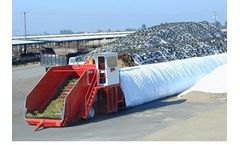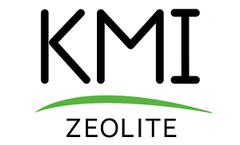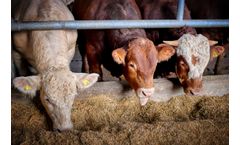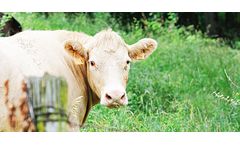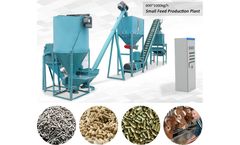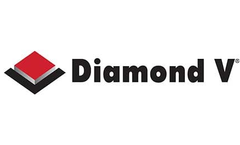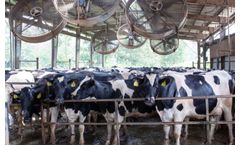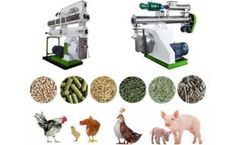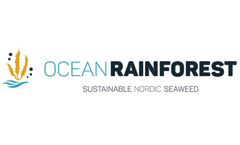Refine by
Rumen Articles & Analysis
24 articles found
In this context, silage provides a high-moisture, energy-rich forage source that supports rumen function and milk production in dairy cows. To support optimal milk production and overall animal health, dry grains are often mixed with silage, hay, and other feed ingredients in a Total Mixed Ration (TMR) to ensure a balanced intake of energy, protein, and fiber. ...
So what’s to know about the differences of silage storage in bags as opposed to piles, bunkers, trenches or dry hay? Plenty! Bagging Silage has been proven to be more cost-effective as well as providing better herd health. Milk production is increased with Dairy Cows and increased weight gain with Beef Cattle. ...
Ruminant animals such as dairy cows, beef cattle, sheep, goats, etc have microorganisms in their first stomach (rumen) that make protein from simple nitrogen compounds. They convert the non-protein nitrogen (NPN) to ammonia and then convert the ammonia to amino acids, which are then converted to proteins. ...
Enhanced Digestive Health and Reduced Digestive Disorders Biochar's impact on rumen health: Research findings suggest that biochar supplementation in ox feed can positively influence the rumen microbial population, leading to improved digestive health and a reduction in digestive disorders. ...
Australia established the National Livestock Identification Scheme (NLIS) more than ten years ago, that is, the quality and safety traceability system of livestock products. The rumen marking ball or ear tag certified by NLIS is used to identify cattle and sheep. ...
Except for ruminant animals that can use part of it with rumen microbes, other animals such as pigs, chickens and other monogastric animals cannot use cellulose. ...
While non-ruminants absorb Mg primarily from the small intestine, ruminants are able to absorb much of their Mg requirement from the rumen. In fact, the reticulum and rumen can account for up to 80% of the Mg absorption along the entire digestive tract (Remond, et al, 1996). ...
Premier recommends the following amounts of MAGOX for dairy buffers. Magnesium Oxide Sources for Rumen Buffers are not Equal MgO for use as an antacid or buffer should be quickly soluble in order to neutralize excess acidity resulting from rapid fermentation of high concentrate rations in the rumen. There are large differences in the rate of ...
Soybean husk has high energy content, and there is no negative reaction of starch grains to inhibit rumen fiber hydrolysis, so it has great potential as a new feed resource for ruminant animal feed mill ...
The full swing of summer will bring high temperatures, high humidity, and high chances of heat stress. Heat stress is a major concern in the beef industry, causing countless problems in cattle, such as a decrease in feed intake, diminished digestibility, and a significant negative impact on performance. High temperatures can cause cattle to reduce feed intake, which can negatively affect ...
Summer is here and with it comes high temperatures, high humidity, and increased chances of heat stress. According to a 2019 Foundation for Food and Agriculture Research study, the US dairy industry experiences $1.5 billion in losses to heat stress annually. With afternoon humidities of 60-70%, and temperatures at 75-77°F, cows may already begin to experience the effects of heat stress ...
The goal should be to minimize the time that rumen pH drops below 5.8. Without a healthy microbial population and suitable pH , the rumen becomes less efficient at digesting feed. So, how can you build a healthy rumen environment? Incorporate these three tips listed below. Create the Right Balance in the Ration A healthy ...
Granulated feed can also assist livestock to grind teeth and increase rumen function. 4. Different livestock corresponding to different specifications of pellet feed. ...
Certain types of seaweed contain strong antioxidants and tannins which can help stop the development of methane in the cows’ rumens. Climate Feed has a project budget amounting to 17M DKK, of which 11.7M have been donated by Innovation Fund Denmark. ...
Early maternal separation could impair rumen microbial colonization in early life, which would then affect rumen function and ultimately impact animal health and performance. In this context, probiotics could be used as a nutritional tool to optimize rumen microbial establishment. Based on this assumption, a study was conducted at INRA using ...
Early maternal separation could impair rumen microbial colonization in early life, which would then affect rumen function and ultimately impact animal health and performance. In this context, probiotics could be used as a nutritional tool to optimize rumen microbial establishment. Based on this assumption, a study was conducted at INRA using ...
Basically, they have a fluid-filled digestive organ—the rumen—that allows them to use roughages, like hay and grass, as a major source of nutrients. The microbes within the rumen can actually breakdown cellulose and hemicellulose for digestion, an ability that most other mammals—like humans—lack. ...
Anaerobic bacteria capable of decolourising Turquoise HGN dye were isolated by roll tube technique from enrichments inoculated with rumen fluid and were tested for their decolourisation efficiency under different conditions. ...
The present study investigated the effects of a feed additive and rumen microbial modifier, monensin sodium (monensin), on selected variables in lactating dairy cows. ...
Leaf blade, sheath, and stem of immature (1-m plant height) and mature (silage) growth stages were analyzed for ferulate esters and ethers, cell wall concentration and composition, and in vitro rumen degradability. The sfe lines were taller and had greater internode cross-sectional area than W23. ...


